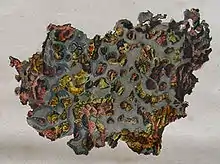| Krasnojarsk | |
|---|---|
 Hand-colored drawing | |
| Type | Stony–iron |
| Structural classification | Medium octahedrite |
| Class | Pallasite |
| Group | Pallasite Main Group |
| Country | Russia |
| Region | Krasnoyarsk Krai |
| Coordinates | 54°54′N 91°48′E / 54.900°N 91.800°E[1] |
| Observed fall | No |
| Found date | 1749 |
| TKW | 700 kg |
History
A mass of about 700 kilograms (1,500 lb) was detected in 1749 about 145 miles south of Krasnoyarsk.The meteorite was found in 1749 by the local blacksmith Yakov Medvedev and the mining foreman IK Mettikh who reported the find near the village of Medvedevo (the current territory of the Komsky Rural Council of the Novosyolovsky district of the Krasnoyarsk Krai).
In 1772, the unusual block was shown to Academician P.S.Pallas, who at that time was in those parts with an expedition. On his instructions, the bulk of the lump, weighing about 40 pounds, was sent in 1773 to St. Petersburg, and in 1777 - delivered to the Kunstkamera.
Krasnojarsk was the first pallasite ever found and studied first time as meteorite in 1794 by Ernst Chladni,[2] and led to the creation of the Pallasite group, named after Pallas.
It was also the first meteorite ever etched with acid (by G. Thomson) and therefore was the first one to show to human eyes the Widmanstätten pattern.
The main mass of 514.557 kilograms (1,134.40 lb) is now in Moscow at the Fersman Mineralogical Museum, Russian Academy of Sciences.
Composition and classification

It is a stony–iron meteorite of the Main Group Pallasite (MGP) group.
See also
References
- ↑ Meteoritical Bulletin Database: Krasnojarsk
- ↑ Chladni E. Üeber den Ursprung der von Pallas gefundenen und anderer ihr ähnlicher Eisenmassen, und über einige damit in Verbindung stehende Naturerscheinungen. Riga: Hartknoch, 1794. 63 S.